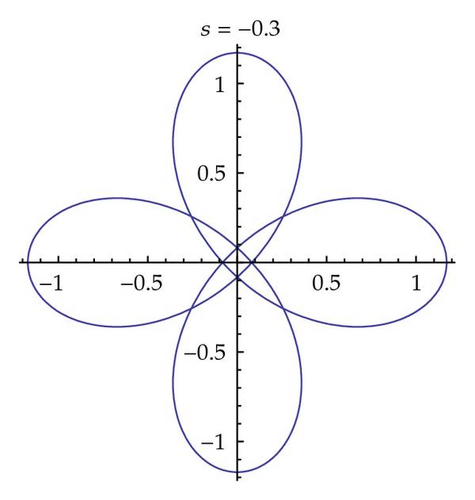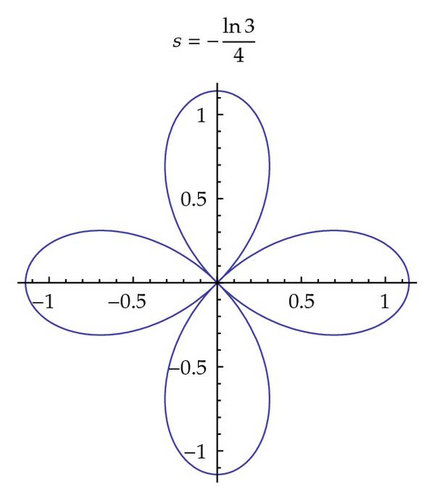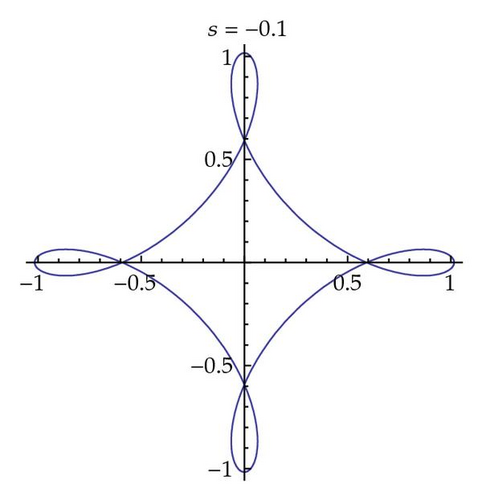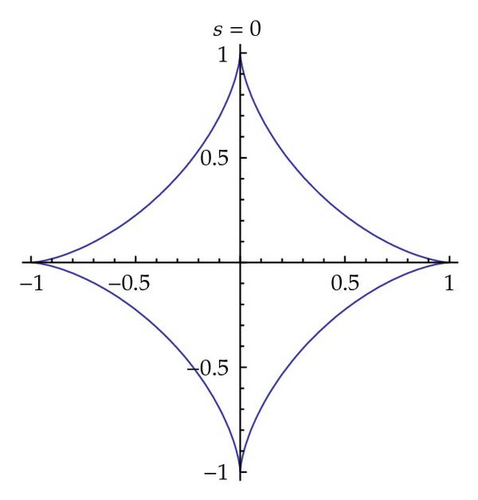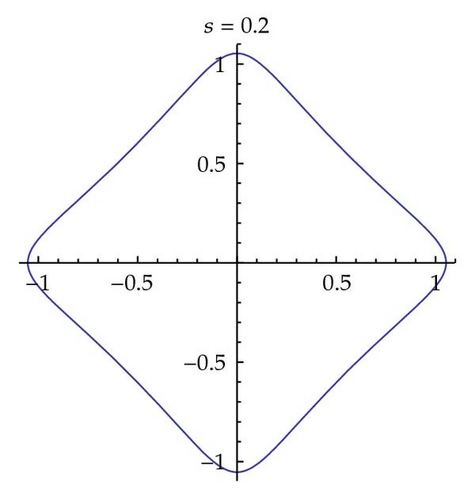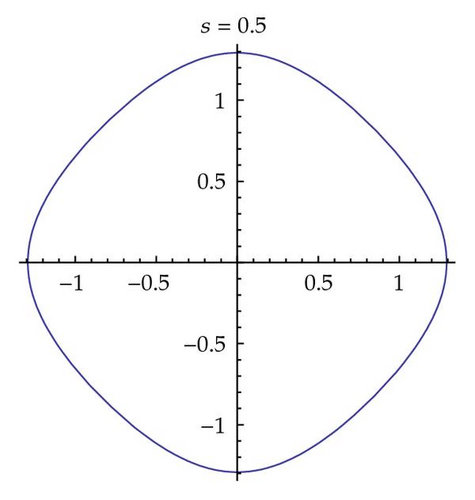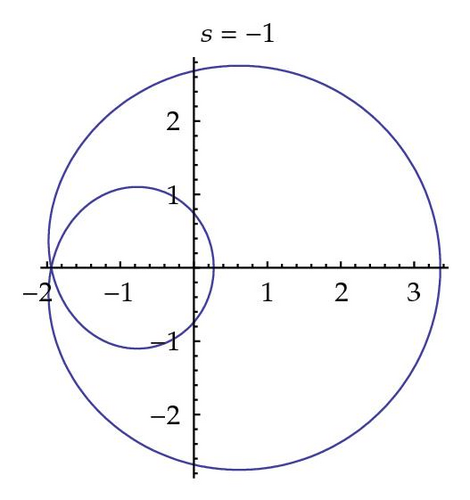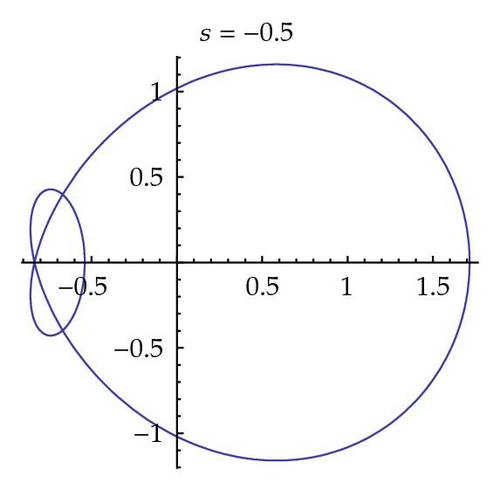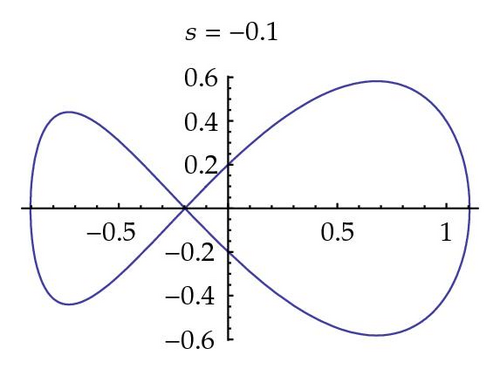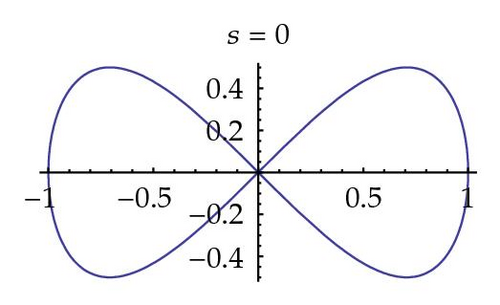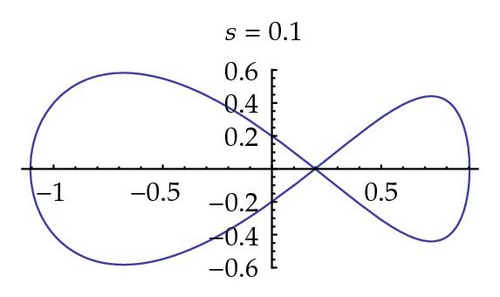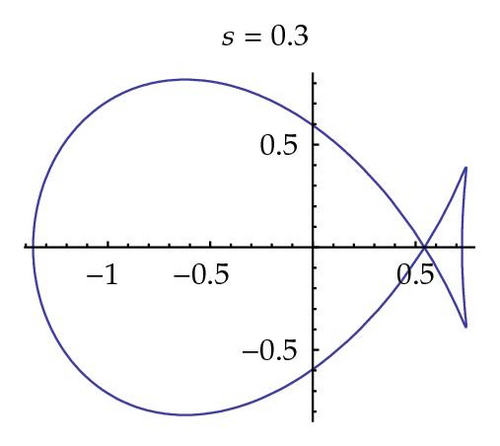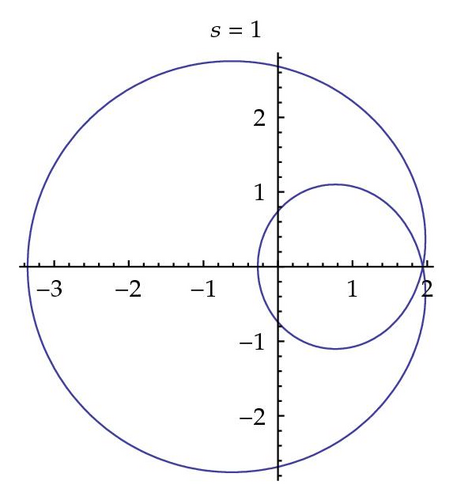1. Introduction
Let Ω⊆
ℝ2 be an open set. A function
h : Ω →
ℝ with continuous second partial derivatives is called
harmonic if (
∂2h(
x,
y))/(
∂x2)+(
∂2h(
x,
y))/(
∂y2) = 0 for all (
x,
y) ∈ Ω. As is well known, such a function has the following mean value property: for every disk {
z ∈
ℝ2; |
z −
z0| ≤
r}⊆Ω,
z0 = (
x0,
y0),
r ≥ 0, it holds that
(1.1)
Now let us look at this property from a slightly different point of view. We will not consider the recovering of h at the center of the circle as crucial but the fact that the left side of (1.1) is independent of r. In other words, h has the same mean value over all concentric circles with center (x0, y0).
We give two further examples.
Let us consider a family of confocal ellipses in Ω, centered at (0,0). Taking (−
c, 0) and (
c, 0) for their foci (
c > 0), the ellipses are given by equations of the form
x2/(
c2cosh
2r) +
y2/(
c2 sinh
2r) = 1. For a harmonic function
h : Ω →
ℝ, it then holds (see, e.g., [
1]) that
(1.2)
(Here, of course, it is necessary that Ω contains the interiors of all ellipses of the family.) Therefore, the left side of (
1.2) is independent of
r, and
h has the same mean value (in this precise sense) over all confocal ellipses with foci at (−
c, 0) and (
c, 0).
Finally, let Ω be so big that it contains a family of confocal hyperbolas (together with their interiors) with foci at (−
c, 0) and (
c, 0) (
c > 0). Such hyperbolas emerge from equations of the form
x2/(
c2cos
2r) −
y2/(
c2sin
2r) = 1, and we restrict ourselves to their “right” branches (
x > 0). For a bounded harmonic function
h : Ω →
ℝ, for which there exists
r0 > 0 such that
t ↦
h(
ccos
r0cosh
t,
csin
r0sinh
t) is integrable over
ℝ, it then holds for 0 ≤
r ≤
r0 [
2] that
(1.3)
Again, the left side is independent of
r, and
h has the same mean value over all these confocal hyperbolas.
Thus, naturally the question arises, whether, given a curve in Ω, it can be deformed in such a way that the mean value over it of a harmonic function does not change. In this paper we introduce a general principle of deformation and derive the equations of the family curves explicitly. This principle serves a double purpose: on the one hand it offers a unified reasoning for (1.1), (1.2), and (1.3), and on the other it turns out to be a source of further examples of families of curves that leave the harmonic mean value unchanged.
Now let us set out the framework and specify the notion of “mean value” that we are going to study.
Let
I⊆
ℝ be an interval,
(1.4)
a smooth curve in an open and simply connected set Ω⊆
ℝ2. Let
h : Ω →
ℝ be a harmonic function for which
I∋
t ↦
h(
x0(
t),
y0(
t)) is integrable. We then search for functions
x(
s,
t) and
y(
s,
t) defined on some
J ×
I, where
J is an interval with 0 ∈
J, such that
(1.5)
(1.6)
(1.7)
The last equation will be regarded as the invariance of the mean value of
h over the curves
t ↦ (
x(
s,
t),
y(
s,
t)) for all
s ∈
J.
Having the examples (
1.1), (
1.2), and (
1.3) in mind, we now make the following assumption. If
is a harmonic conjugate function to
h (i.e.,
is holomorphic on Ω), then
is bounded and
(1.8)
This is not really a restriction when
I is compact and all the curves of the family are closed (the boundedness of
can be achieved by shrinking Ω), but it is crucial in situations like (
1.3), where
I has infinite length. (It seems that the use of
is no less than the key, which opens the way to a unified treatment of the cases of bounded and unbounded
I. It also seems unlikely that the conditions of boundedness and (
1.8) for
could be formulated in terms of
h. (Consider, e.g.,
h(
x,
y) ≡
x on Ω
1 : =
ℝ×] − 1,1[ and on Ω
2 : = {(
x,
y)
;
|
y| < 1 + |
x|}.)
In this framework we are going to show that if
(1.9)
is a
conformal mapping satisfying (
1.5), (
1.6), and (
1.8), then (
1.7) holds. This will establish the principle of deformation.
In the present paper we restrict ourselves to mean values where the measure is given by the curve parameter
t. (Note that a parameter change affects the conformality of (
1.9) because of (
1.6).) However, the same principle of deformation can serve to treat more general cases of measures, where a weight function
w enters:
(1.10)
Since this is far more difficult, it will be studied in a future paper.
2. Principle and Equations of Deformation
The principle of deformation is as follows.
Theorem 2.1. Let Ω⊆ℝ2 be a simply connected open set, t ↦ (x0(t), y0(t)) ∈ Ω a smooth curve defined on an interval I⊆ℝ. Furthermore, let J⊆ℝ be an open interval with 0 ∈ J and
(2.1)
a smooth function satisfying
(2.2)
and (
1.6).
If h : Ω → ℝ is a harmonic function for which there exists a bounded harmonic conjugate and (1.8) holds, then (1.7) holds.
Proof. Since Ω is simply connected, a harmonic conjugate function to h exists and is determined up to a constant. We fix such an and assume it bounded.
Let [a, b]⊆I. It then holds that
(2.3)
Therefore,
(2.4)
Now, since
is bounded, the limit for
b → sup
I and
a → inf
I on the right side can be taken under the integral sign, and (
1.7) is established.
On the basis of this theorem we derive the equations of deformation.
From (
2.2) it follows that there exists
a harmonic function
v =
v(
s,
t) on
J ×
I such that
(2.5)
For this
v, (
1.6) entails that
(2.6)
Thus,
v satisfies a Cauchy problem with initial data (
2.6) and is therefore determined up to an additive constant.
Let us now give a series representation of
v. From (
2.6) and the harmonicity of
v, it inductively follows that
(2.7)
This leads to the series expansion
(2.8)
on the basis of which, together with (
∂v(0,
t))/
∂t =
x0 (
t), (
2.5) constitutes the equations of deformation. (The
s-interval of convergence of (
2.8) depends, of course, on the initial curve (
x0,
y0). Furthermore, it clearly follows from the equations of deformation that if
I∋
t ↦ (
x0(
t),
y0(
t)) is a
closed curve (which can be extended to a
smooth periodic map for all
t ∈
R), then
I∋
t ↦ (
x(
s,
t),
y(
s,
t)) remains closed for every s ∈
J.)
Such a function v (which is determined up to a constant) will be called a d-potential (from the word deformation) of the curve (x0(t), y0(t)). This should not be confused with the Schwarz potential of this curve (see [3]).
3. Applications
We start by briefly revisiting the situations in (1.1), (1.2), and (1.3), now as applications of the d-potential, and continue with further interesting examples.
(I) If (
x0(
t),
y0(
t)) = (
a +
Rcos
t,
b +
Rsin
t) for
t ∈ [0,2
π], then by (
2.8) and (
∂v(0,
t))/
∂t =
x0(
t) the
d-potential is
(3.1)
So (
2.5) gives
(3.2)
a family parametrized by
s of circles with center (
a,
b).
(II) For the ellipse (
x0(
t),
y0(
t)) = (
acos
t,
bsin
t) with
a >
b > 0 and
t ∈ [0,2
π], we have
(3.3)
This entails that
x(
s,
t) = (
acosh
s +
bsinh
s)cos
t,
y(
s,
t) = (
asinh
s +
bcosh
s)sin
t, so
(3.4)
with
and
s0 = arsinh(
b/
c). This is a family parametrized by
s of confocal ellipses with foci at (−
c, 0) and (
c, 0).
(III) For the hyperbola (
x0(
t),
y0(
t)) = (
acosh
t,
bsinh
t) with
a,
b > 0 and
t ∈
ℝ, we have
(3.5)
which gives
x(
s,
t) = (
acos
s +
bsin
s)cosh
t,
y(
s,
t) = (
bcos
s −
asin
s)sinh
t, so
(3.6)
with
and
s0 = arcsin(
b/
c). This is a family of confocal hyperbolas with foci at (−
c, 0) and (
c, 0). Of course, here we have to put the conditions of boundedness and (
1.8) for
. In particular, if
h is defined on the “right” half-plane and is continuous into the boundary, then it holds (
s↘
s0 − (
π/2)
,
s →
s0) that
(3.7)
(IV) Let Ω be the upper half-plane. For the base curve we take the straight line (
x0(
t),
y0(
t)) = (
t, 1) with
t ∈
ℝ. Then,
(3.8)
and
x(
s,
t) =
t,
y(
s,
t) = −
s + 1. Thus, under the mentioned conditions on
, a harmonic function
h on Ω has the same integral over all straight lines parallel to the boundary.
(V) Consider the starlike curve (
x0(
t),
y0(
t)) = (cos
3t, sin
3t) for
t ∈ [0,2
π]. On the basis of the relations cos
3t = (cos (3
t) + 3cos
t)/4 and sin
3t = (3sin
t − sin(3
t))/4, arbitrary derivatives can be computed as follows:
(3.9)
This allows the
d-potential to be given explicitly as follows:
(3.10)
with
d ∈
ℝ. This results in the following family of curves:
(3.11)
Figure
1 exhibits some distinct curves of the family. (All figures in this paper have been produced with
Mathematica.) The one for
s = −(ln 3)/4 may be of particular interest, where the double point is (0,0):
(3.12)
This curve satisfies the equation
and resembles a lemniscate. (Bernoulli′s lemniscate is given by
,
c > 0.)
(VI) It seems difficult to compute the
d-potential of Bernoulli′s lemniscate explicitly. The opposite is true in the case of Gerono′s lemniscate with equation
x4 =
a2(
x2 −
y2),
a > 0. It is parametrized by
(3.13)
We have
,
, so
(3.14)
This gives
(3.15)
Figure
2 shows some snapshots of the family.
(VII) For the infinitely extended cycloid
(3.16)
(Ω being a suitable half-plane), we have
for
k ≥ 2,
for
k ≥ 1, so
(3.17)
The result is
(3.18)
which is a prolate cycloid for
s < 0 and a curtate one for
s > 0 (up to a vertical displacement by |
s|).
